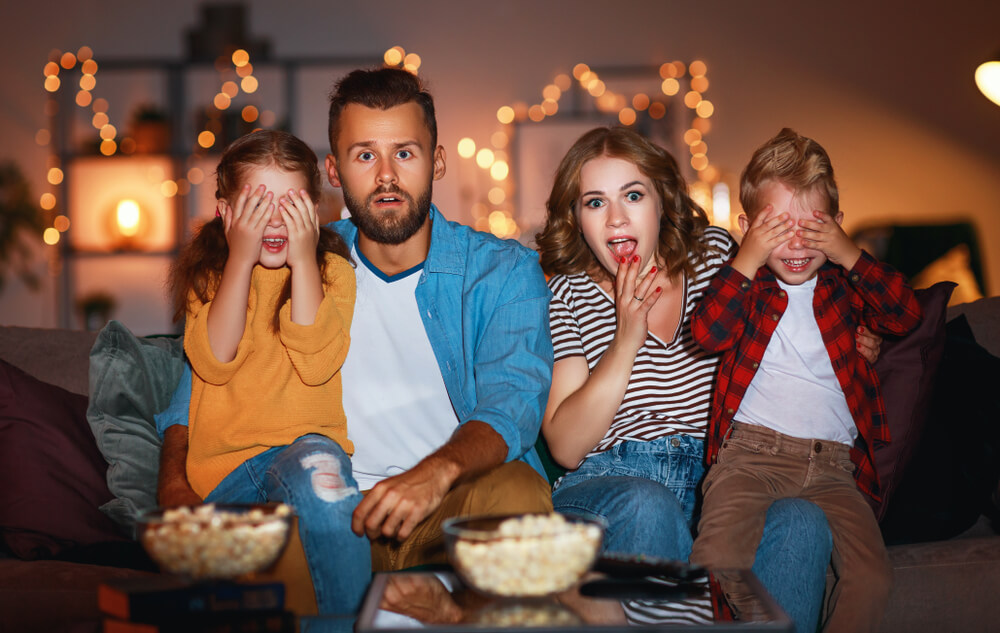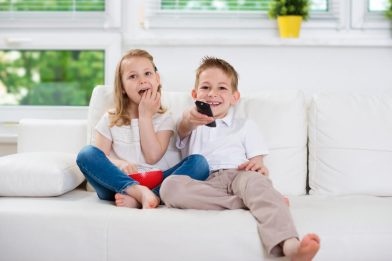How to Teach the Child to Get Dressed On Their Own: All Secrets
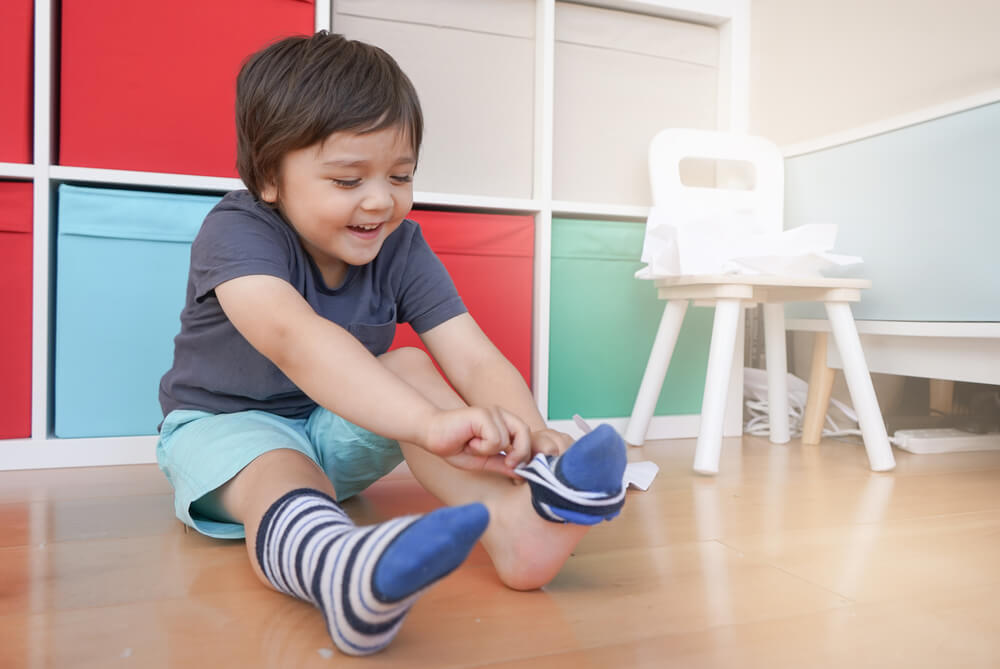
Learning to get dressed is one of the most important early steps in child development, helping children build independence, motor dexterity, and confidence while growing up.
The morning of almost every mother of a preschooler is like a real marathon: she needs to wake up the child, bathe them, feed them, dress them, and put on their shoes. At the same time, she needs to get herself ready and not be late for work.
If your morning starts this way, this article is for you.
Today, we will discuss how to avoid a “marathon race” every day and teach your child to dress independently. We will also learn the secrets of choosing children’s clothes and discuss the mistakes that parents make when it comes to dressing or undressing their child.
Contents:
- At What Age Should a Child Get Dressed On Their Own?
- Why Do Children Not Want to Get Dressed On Their Own?
- Teaching the Child to Dress Without the Help
- Choosing the Right Clothes
- The Child Doesn’t Like to Get Dressed: Secret Tips for Moms and Dads
- FAQs
At What Age Should a Child Get Dressed On Their Own?
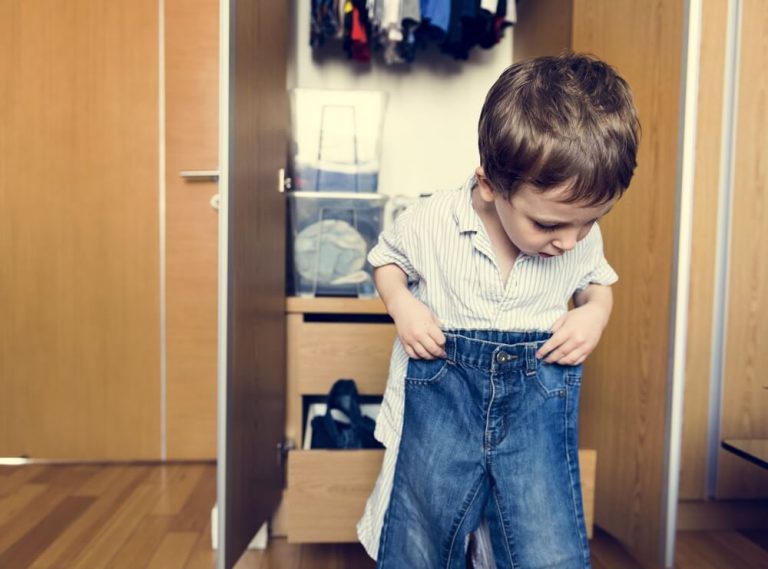
Rawpixel.com/Shutterstock.com
Psychologists and teachers agree that children should be able to dress independently by the time they start kindergarten, typically between the ages of 2 and 3 years old.
At this age, the child begins to strive for independence, which means it is time to give them more autonomy. Let them try to put on socks, a t-shirt, a jacket, or fasten their shoes. Be sure to praise them for every action by telling them how well they are getting on.
This milestone connects to cognitive skills, sequence awareness, and fine motor dexterity, which gradually develop as part of normal child development.
The programs developed for kindergartens clearly list all autonomous skills that children should master at different ages. Many Montessori educators, inspired by Maria Montessori, include activities like the Montessori Coat Flip to reinforce dressing steps.
You can check and see if your child is ahead of or behind their age norms.
2 years old
The child takes off and puts on tights, a t-shirt, a dress, or pants, all in the correct order. An adult helps the baby to open and close buttons, zippers, and other fasteners.
3 years old
The child can independently fasten and unfasten simple fasteners and hang clothes on their chair. They watch over their clothes during the day without additional reminders. For example, pulling down their dress or tucking their T-shirt into their pants.
4 years old
The child dresses and undresses independently. An adult helps them to tie their shoelaces, as well as to fasten and unfasten the side and back zippers.
5 years old
The child can tie their own shoelaces. They fold clothes neatly in the closet and can monitor its cleanliness.
6 years old
The child dresses and undresses themselves. They can take care of their clothes and use a cloth and/or a shoe brush.
Before the age of 1.5 years, it is not recommended to teach dressing skills to the child, as their fine motor skills and hand coordination are not yet sufficiently developed.
Why Do Children Not Want to Get Dressed On Their Own?

LightField Studios/Shutterstock.com
There are several reasons why children may struggle to dress themselves without the help of an adult.
1. The child doesn’t know how to do it
This situation is typical for parents who have been dressing their child until the age of 4-5 years old and then suddenly decide that it is time for them to do it on their own. At this point, mom or dad puts a pile of clothes in front of the child, and they don’t even know what to do with it.
2. They find the process boring
Yes, this is also one of the reasons. Inventive parents solve this problem in a simple way: they turn the dressing process into an entertaining game or competition, whilst reciting short rhymes or tales together with the child.
3. Too much uncomfortable clothing
A child of 2-3 years old will be much more comfortable wearing a scarf rather than a shirt front, a T-shirt instead of a turtleneck, etc.
4. The child is feeling unwell
Sometimes, a refusal to dress is associated with a child’s bad mood or feeling unwell. Children have not yet developed self-control, so they cannot force themselves to perform actions requiring attention and skills when upset about something.
What is recommended in this case? Dress the child up yourself and then take the time to explain what happened: “You were upset because of the broken car today, and you couldn’t get yourself dressed, so I had to help you. Let’s agree that when we arrive at the kindergarten, you will take your coat off and carefully hang it in your locker”.
5. The child has sensory issues or special needs
Sometimes, children experience sensory issues or sensitivities that make certain clothing items feel uncomfortable. As a result, they may resist getting dressed or refuse to wear specific clothes.
Some children, such as those with autism or ADHD, may face additional challenges due to sensory sensitivities or difficulties with sequence awareness. In these cases, structured routines, occupational therapy, and the use of visual cues can make the process smoother. Specialists—such as pediatric or adolescent occupational therapists—can also help parents break down dressing into manageable steps.
Do not worry about your child when they are in kindergarten. Check if they managed to dress themselves to go on a walk and find out how they are doing with the Findmykids app and children’s GPS watch. Listen to the sounds around them and see the location of the child at any time!
Teaching the Child to Dress Without the Help
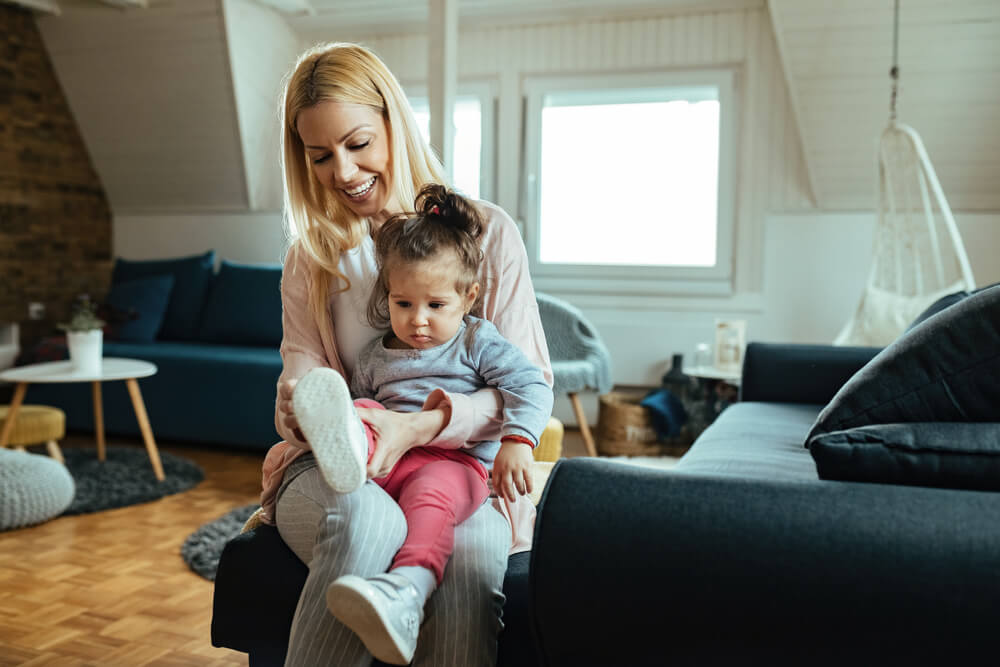
Drazen Zigic/Shutterstock.com
What to Start With?
- First, the baby must be taught to undress. This skill is easier to acquire. At an early age, children often try to take off their mittens, panamas, or sandals. Invite the child to try to put on the item they took off on their own, and be sure to praise them for their efforts.
- It is easier for children to dress and undress in a sitting position, so be sure to provide a small chair for your baby.
- While playing, a child often puts on their mother’s or father’s clothes. Don’t forbid them to do so. This allows them to develop an interest in clothing and the process of dressing.
- Clothes made of elastic fabrics without fasteners and zippers work well for a child who is just starting to learn how to dress themselves.
- Develop self-care skills in a game format. Fold your child’s clothes in a place that would be easily accessible to them. At first, they will be simply taking it out and throwing it around. However, over time, they will begin to put on a jacket, socks, a hat, etc, following the example of adults.
5 Main Rules

Natal.is/Shutterstock.com
1. Don’t rush the child
Be calm and patient in the process of teaching both self-care and other skills. If you need to take your child to kindergarten in the morning and then go to work, try to get up early to allow some time for the child to dress on their own. In case the child does something incorrectly, invite them to look at themselves carefully and find the mistake.
2. Talk through what you are putting on
When you are just teaching a child to dress, it is important to name the correct algorithm for this process out loud. You’ll need to say, “First, we put on tights, then a sock on the right leg, and then on the left. After this, a blouse, and now a jumpsuit.”
The child will remember the correct sequence and will soon be able to reproduce it on their own.
3. Provide more autonomy
Try to provide the child with opportunities for independent actions at every step of the process of getting dressed and taking their clothes off. This way, they will learn faster. For example, you start taking off the tights, and the child completes this action.
Additionally, give your child the opportunity to choose their own clothes.
4. Don’t forget to praise the child
Even if a three-year-old kid puts on their T-shirt backwards and forgets to fasten their sandals, praise them anyway. Do not scold, criticize, or even more so, laugh at the child.
It is also not recommended to compare the child with other children who are more successful in this matter, by, for instance, saying, “Look how quickly Matthew got dressed today, and you are still struggling”.
5. Develop the skills of orientation in space
Teach your little one how to tell right from wrong, front from back, and show them some tips to dress quickly and with more ease. For example, in order to put on a jacket correctly, it is better to put on the hood first, and then it will immediately be clear where the right and left sleeves are.
These rules not only develop independence but also strengthen cognitive skills and prepare the child for daily life as part of growing up.
Which Mistakes Should be Avoided?
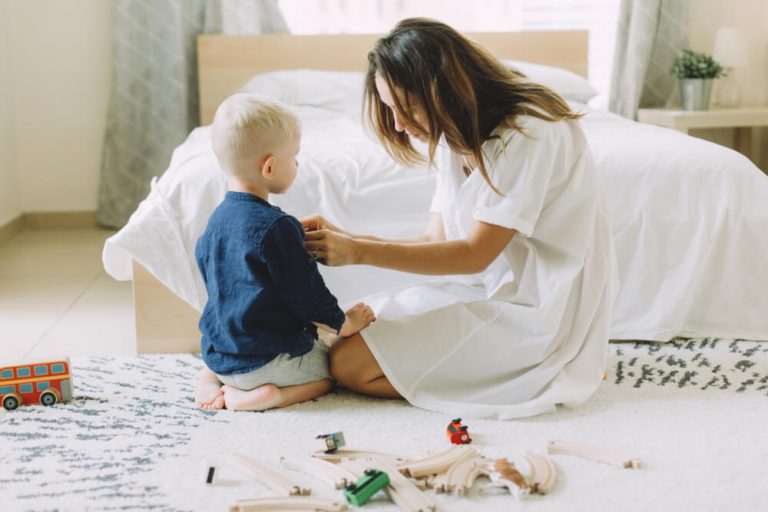
Tanya Yatsenko/Shutterstock.com
Mistake №1
Tom’s mother is always rushing. In the morning, she runs into the kindergarten, quickly takes her son’s coat off, and runs off to work. In the evening, she also hurries to take Peter swimming, dresses him up quickly, and leaves the kindergarten with him.
At the age of 5, Tom cannot put on a jacket on their own, nor can he zip it up. He is always waiting for help from the teacher, whilst all the other children are already dressed.
In some families, it’s really customary to live in a state of eternal time pressure. Parents simply do not have the patience to watch a small child dress or undress on their own.
Until you learn how to manage your time, the situation will not change. The child needs time to put on tights, socks, etc., without any haste and fuss. This is the only way for them to learn this. This will enable them to get dressed quickly over time.
Mistake №2
The mother of four-year-old Kate is constantly scolding her daughter in the morning in the locker room of the kindergarten. It is for pulling the tights badly, fastening the zipper crookedly, putting slippers on the wrong foot, etc. Kate is already used to her mother’s remarks and does not pay attention to them; she just stands there and sighs. The annoyed mother achieves the perfect appearance of her daughter on her own, and only then lets her go to her classes in kindergarten.
Of course, all mothers want their child to look neat and tidy, but it is useless to demand this from kids aged 4-5 years old. They have not yet fully developed fine motor skills, so many movements are difficult for them. The child is in need of constant practice in order to learn how to fasten a zipper or not to confuse right and left.
Mistake №3
Steve’s mother, unlike Tom’s, sits with her son in the locker room for a long time and takes his coat off herself. This way, she’d be calm. After all, if Tom starts doing it himself, he will likely start acting up and crying.
Very often, the parents themselves prevent the child from mastering new skills. Of course, it is much more convenient and calmer to dress or undress the child yourself, but what will they learn this way?
During undressing or dressing, children tend to act up in two situations. They are either rushed or they do not know how to cope with complex fasteners and zippers on clothing items. Therefore, this problem is solved either by some extra time or by simple and comfortable clothing.
Games That Help to Develop the Skill of Getting Dressed

Natalia Lebedinskaia/Shutterstock.com
Any skill needs to be reinforced. Otherwise, the new skill acquired by the child will be quickly forgotten. This also applies to self-sufficiency skills. It is imperative to consolidate what the child has learned. The following games and exercises can help with this:
- Games with fingers: They help to develop fine motor skills and coordination.
- Creating models and drawing: The child should be doing some activities not only in kindergarten, but also at home.
- Playing with laces: Make your own toy or buy a cardboard or plastic one. It should have holes through which the lace needs to be put. Busy Boards are also popular now; these are wooden boards or houses, on which many elements can be placed. They are designed to develop fine motor skills in babies, with the help of locks, zippers, buttons, and gears.
- Games with buttons of different sizes: “Find two identical buttons”, “Pick up a suitable button for a jacket”, “Lay out a pattern from buttons”, and others.
- Games with dolls: Whilst dressing and undressing the doll, the child will quickly remember the correct sequence of putting the clothes on and practice fastening zippers and buttons.
- Fashion show: Lay out your own and children’s clothes in front of the child, as well as hats, gloves, scarves, and other accessories, and offer them to dress up and “walk on the catwalk”.
What is Important for Parents to Know?
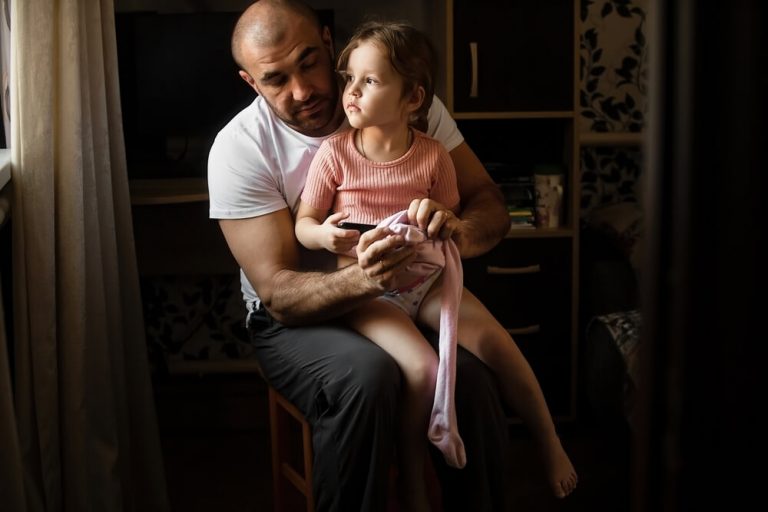
olgaarmawir/Shutterstock.com
- The child’s clothes should be within their reach, allowing them to easily access and put them on at any time. In kindergartens, all lockers for clothes or hooks for coats are located at the child’s height for the same reason, of course.
- When choosing clothes for your son or daughter, consider whether they will be comfortable for the child to wear in the first place.
- If the child is having trouble memorizing the correct dressing algorithm, draw or buy a poster with it and hang it in the children’s room or in the hallway.
- Clothes for a child in kindergarten, a special event, or a visit to the countryside to see their grandmother should be prepared in advance.
- So that the baby is not bored with the long process of dressing, you can arrange a “Who will dress faster” competition, in which mom and dad should at least sometimes let their child win.
- A child cannot master any skill in a couple of days. Therefore, do not make a tragedy out of the fact that the baby refused to put on tights or pants on their own. Be patient. Put some clothes on them, and offer them to do the rest.
- The child should like the clothes they wear. This way, they will be happy to take them off or put them on.
Choosing the Right Clothes
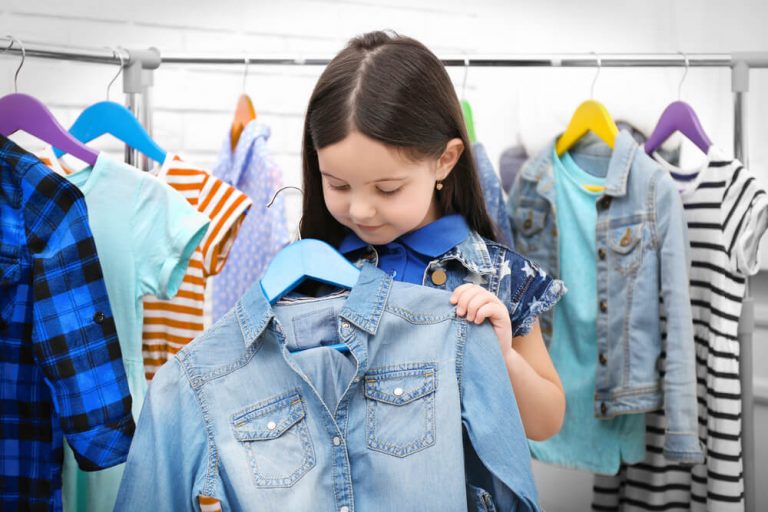
Africa Studio/Shutterstock.com
When choosing clothes for a child, we recommend that you use the following tips :
- First of all, clothes should be comfortable and convenient. They shouldn’t be restraining the child’s movements.
- Give preference to natural fabrics over synthetic ones.
- Pay attention to the neck of sweaters and turtlenecks—they should be wide enough for the child’s head to fit freely through them.
- Ruffles and embroidery are fine for special occasions, but they wouldn’t work for everyday usage.
- For walks, opt for clothes made of thick and waterproof fabric.
- Leave zippers and buttons on clothes for older age. As for shoes, sneakers or Velcro sandals are perfectly suitable for children aged two to three years old.
- To make it easier for your baby to distinguish between the front and the back, choose t-shirts with a bright pattern or an image on the front.
- Do not forget that in kindergarten, children play, walk, crawl on their knees, and do not always eat carefully; therefore, it makes no sense to buy expensive, branded clothes for a child.
- Earrings or other jewelry are also better postponed for older age.
- It is better to replace gloves with mittens until the child learns to put them on.
The Child Doesn’t Like to Get Dressed: Secret Tips for Moms and Dads
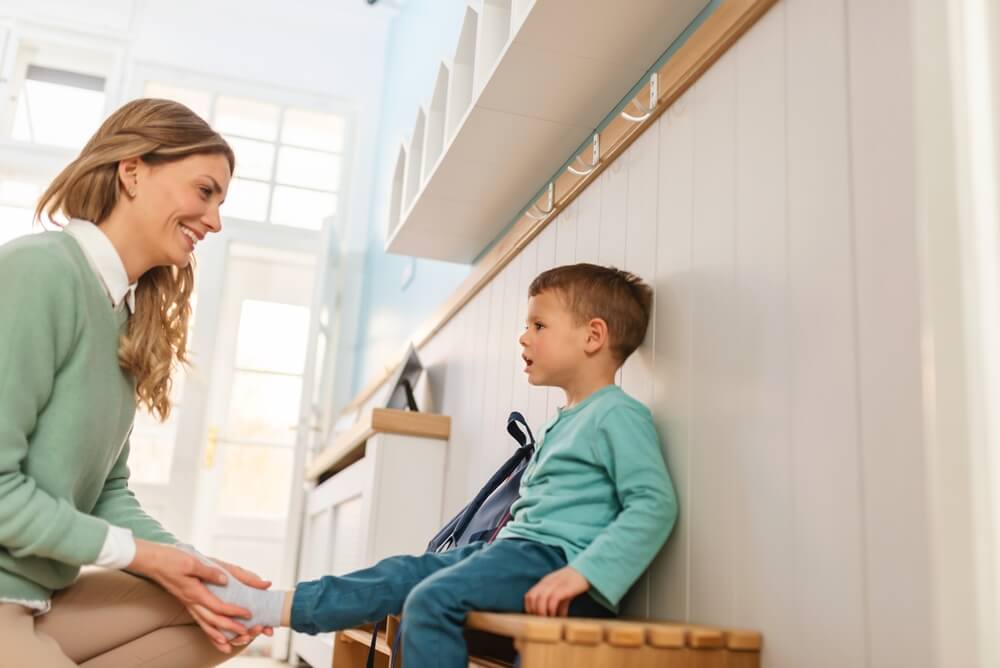
Lordn/Shutterstock.com
If you have tried all the methods described, and the child is still running away from you when they hear the word “dress” and shouts that they will never do this, it is time to use some secret tricks.
There is nothing complicated in them; they would only require some amount of ingenuity and imagination from the parents.
Marcus Stevens, author and illustrator of children’s books, offers the following tips to parents:
- Recite the same poems or rhymes when dressing the baby, for example, “12345 once I caught a fish alive” or “Head, shoulders, knees and toes”.
- Hang the baby’s clothes on a string and put them on the child, taking them off by one clothing piece at a time.
- Put an open book in front of the child and invite them to get dressed with a bear, bunny, or kitten. The book “We can get dressed” by Marion Cocklico would work perfectly well for this activity.
Games, rhymes, and books can help keep the process fun. Some parents also arrange “Who can dress faster” contests. Adding visual cues or playful methods like the Montessori Coat Flip can make learning easier for children struggling with sequence awareness and getting dressed.
The ability to dress independently, like any other skill, does not develop immediately. The main idea is not to forget to praise your baby, not to rush them, and to always support them! This way, your child will feel more “grown-up” and independent, and will learn everything very quickly.
FAQs
At what age should a child be able to get dressed?
Most children can start basic dressing steps around age 2–3, with independence improving steadily until age 6.
What is the meaning of “get dressed?”
It refers to the act of putting on clothing items in the correct order, a key part of daily self-care.
How to help an ADHD child get dressed?
Use consistent routines, break tasks into small dressing steps, and introduce visual cues. Occupational therapy can also support focus and independence.
How to teach an autistic child to get dressed?
Offer clothing options with comfortable fabrics, minimize sensory issues, and use sequence awareness supports like posters. Work closely with a mental health or occupational therapist if needed.
The picture on the front page: Ann in the uk/Shutterstock.com
Проверьте электронный ящик














